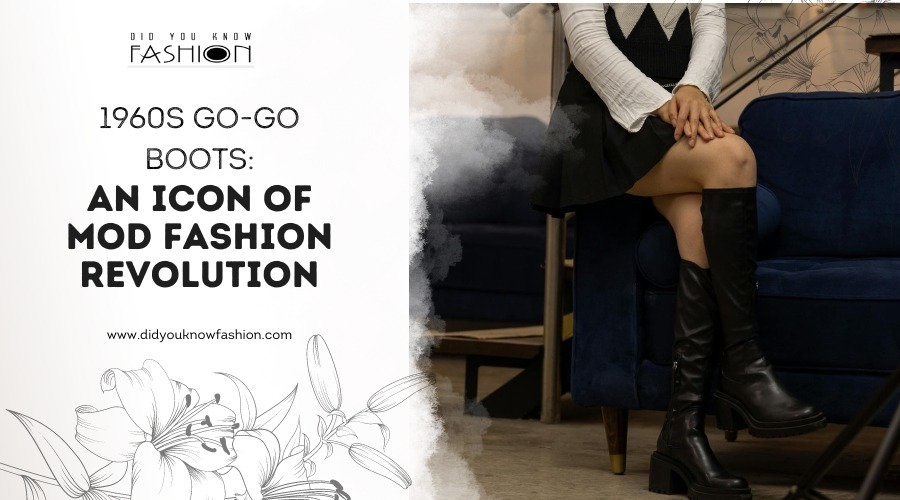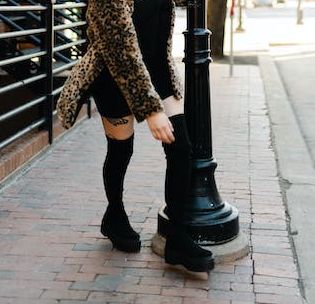Go-go boots emerged as an iconic symbol of the mid-1960s fashion scene, encapsulating the era’s vibrant and youthful spirit. Initially introduced by French designer André Courrèges in 1964, these fashion boots quickly became synonymous with the energetic “go-go” dancers of the time. Characterized by their low heels and mid-calf height, the classic go-go boot often featured a white patent leather finish, although variations in color and material became popular as the trend spread.
As a fashion statement, go-go boots were more than just practical footwear—they represented the era’s break from traditional style and the embrace of a more liberated, bold aesthetic. Women sported these boots with miniskirts and shift dresses, embodying the modern look that defined the swinging ’60s. The popularity of go-go boots was not just limited to the dance floor; they became a staple for women seeking a contemporary, fashionable edge to their everyday attire.
Origins and Popularity
The iconic go-go boots gained momentum in the mid-1960s, becoming a fashion symbol of empowerment and style, greatly influenced by notable figures and media.
Rise in the 1960s
Go-go boots emerged as a defining element of 1960s fashion, initially introduced and popularized by French designer André Courrèges. They were typically white, mid-calf in height, and featured a low heel, making them conducive to dancing and movement. Their appeal was further propelled by the era’s youth-oriented culture and the mod fashion movement. Women often paired these boots with miniskirts and dresses, reinforcing their status as a symbol of the modern, fashionable woman.
Iconic Status via Nancy Sinatra
Nancy Sinatra played a pivotal role in cementing the go-go boot’s place in pop culture history. Her 1966 hit song, “These Boots Are Made for Walkin’,” became an anthem that showcased go-go boots as an extension of the newfound confidence and self-expression among women. The boots featured prominently in her performances and across various television shows, elevating them beyond a fashion statement to an emblem of the era’s spirit. The association between Sinatra and go-go boots was so powerful that it influenced their popularity, making them a must-have item of the decade.
Design and Styles
Go-go boots of the 1960s reflected the era’s innovative spirit through their distinct design elements and style variations. They showcased a range of colors, materials, and heights, becoming a notable fashion statement.
Color Variations
Initially, go-go boots were predominantly white, aligning with the modern and space-age aesthetic of the 1960s. However, as the trend evolved, a wider color palette emerged. Red and tan became popular choices for those looking to make a more vibrant or subtle statement, respectively.
Material Choices
The materials used for go-go boots varied. The classic look was often crafted from leather, which provided durability and a high-quality finish. As the style became more widespread, vinyl boots also gained popularity due to their glossy appearance and affordability.
Height Variations
Go-go boots were available in various heights to suit different preferences and occasions. The iconic style typically reached mid-calf, which complemented the mini skirts of the era. Some designs extended to knee-high lengths, offering a more dramatic look and additional warmth.
Cultural Impact
The rise of go-go boots in the 1960s marked a significant shift in cultural trends, closely intertwined with the era’s liberating dance craze and evolving fashion norms, particularly reflecting women’s changing role in society.
Go-go Dancing Influence
Go-go dancers, often seen on television shows and in nightclubs, popularized these fashion boots. Go-go boots were not just footwear; they were a performance enhancer for the dance floor. The boots’ comfort and flexibility facilitated the tireless, high-energy dancing that became synonymous with go-go dancers. Their presence in media collections of the era enshrined them as a symbol of the period’s youth culture and its penchant for expressive and liberated dance forms.
Fashion and Feminism
The integration of go-go boots into women’s fashion collections was an act of both style and statement. Women embraced the bold-colored boots, commonly seen in white but available in a spectrum of colors, to complement miniskirts and shift dresses, showcasing a combination of playfulness and empowerment. This fashion choice underscored a connection to feminism, as women asserted their independence and challenged traditional norms through their wardrobe. Go-go boots became an emblem of a woman’s freedom to control her own body and presentation, mirroring the greater societal shifts of the decade.
Buying Guide
When purchasing go-go boots from the 1960s, one must pay attention to ensuring the right fit and knowing how to maintain their condition. This buying guide will provide essential advice for selecting the right pair and offer tips to care for these iconic boots.
Selecting the Right Fit
- Measure Accurately: Ensure to measure the foot size accurately, considering both length and width. Go-go boots should fit snugly without compressing the toes or causing discomfort.
- Consider Boot Shaft and Calf Size: The boot shaft should be the appropriate height and circumference to fit comfortably around the calf without being too tight or too loose.
- Check for Material Flexibility: Go-go boots often come in stretch vinyl or leather, which should have a degree of elasticity to mould to the shape of the leg and foot.
Caring for Go-go Boots
- Proper Cleaning: Clean the boots using materials suitable for the boot’s fabric. For vinyl boots, a damp cloth with mild soap is often recommended, while leather boots may require specific leather cleaners.
- Storage Tips:
- Store them in a cool, dry place away from direct sunlight.
- To maintain their shape, insert a boot shaper or stuff them with acid-free tissue paper.
- Avoid Water Damage: Protect the boots from water and moisture to prevent damage, especially if the material is sensitive like suede or untreated leather.
By considering these specific features and care instructions, one can ensure the longevity and optimal appearance of their go-go boots, making them a valuable addition to any ensemble.
Contemporary Relevance
While originating in the 1960s, go-go boots have experienced resurgences in popularity, as designers and fashion enthusiasts draw on vintage styles to influence modern wardrobes.
Modern Fashion Adaptations
Go-go boots have been reinterpreted by modern fashion to align with contemporary aesthetics while retaining their iconic structure. A common adaptation seen in today’s fashion collections features varying height and length options catering to individual preferences, ranging from ankle to knee-high styles. The sole and heels of these boots have also seen innovation; the traditional low-heeled design is sometimes replaced with block heels or platforms for a modern edge.
The collection of go-go boots today often includes a diverse palette of colors and materials, far beyond the classic white vinyl. Textural elements such as patent leather, suede, and even embellishments like sequins or metallic finishes are commonly utilized. This variety gives wearers the ability to choose boots that complement their unique style.
In terms of fashion pairings, go-go boots continue to be a statement piece. They are frequently paired with minimalist outfits to let the boots stand out, or they can be matched with busier patterns for a bold look. An italicized sweater dress might be worn with a pair of these boots for a nod to their vintage origins while still feeling fresh and modern.
Through these adaptations, go-go boots remain a symbol of self-expression within the fashion world, retaining their heritage as a piece that breaks conventions and embodies a fearless approach to style.




